Selina Concise Physics Class 7 ICSE Solutions – Physical Quantities and Measurement
ICSE SolutionsSelina ICSE SolutionsML Aggarwal Solutions
APlusTopper.com provides step by step solutions for Selina Concise ICSE Solutions for Class 7 Physics. You can download the Selina Concise Physics ICSE Solutions for Class 7 with Free PDF download option. Selina Publishers Concise Physics for Class 7 ICSE Solutions all questions are solved and explained by expert teachers as per ICSE board guidelines.
Selina Class 7 Physics ICSE SolutionsChemistryBiologyMathsGeographyHistory & Civics
Selina Concise ICSE Solutions for Class 7 Physics Chapter 1 Physical Quantities and Measurement
- Points to Remember
- The mass of a body is the quantity of matter contained in a body regardless of its volume or any force acting on it.
- The weight of a body is the force with which every body is attracted towards its centre.
- The unit of mass in S.I. system is kilogram (kg). Higher units of mass are quintal and metric tonne.
- The weight of body changes with acceleration due to gravity.
- Weight is zero at the centre of the earth.
- Mass per unit volume of a substance is called density of the body.
- The unit of density in S.I. system is kg m-3 and gcm-3 in C.G.S. system.
- The density in S.I. system is 1000 × numerical value in C.G.S. system.
- The density of liquids and gases decreases or increases with the rise or fall in temperature.
- The cycle of upward and downward movements of the fluid form currents in the medium which are known as convectional currents.
Test Yourself
A. Objective Questions
1. Write true or false for each statement
(a) The S.I. unit of volume is litre.
Answer. False.
The S.I. unit of volume is cubic metre.
(b) A measuring beaker of capacity 200 ml can measure only the volume. 200 ml of a liquid.
Answer. True.
(c) cm2 is a smaller unit of area than m2.
Answer. True.
(d) Equal volumes of two different substances have equal masses.
Answer. False.
Equalvolumes of two different substances have different masses.
(e) The S.I. unit of density is g cm-3.
Answer. False.
The S.I. unit of density is Kg m-3.
(f) 1 g cm-3 = 1000 kg m-3.
Answer. True.
(g) The density of water is maximum at 4°C.
Answer. True.
(h) The speed 5 ms-1 is less than 25 km h-1.
Answer. True.
(i) The S.I. unit of speed is ms-1.
Answer. True
2. Fill in the blanks
(a) l m3 = 106 cm3
(b) The volume of an irregular solid is determined by the method of displacement of liquid.
(c) Volume of a cube = (one side)
(d) The area of an irregular lamina is measured by using a grapl paper.
(e) Mass = density × volume.
(f) The S.I. unit of density is kg m-3.
(g) 1 g cm-3 = 1000 kg m-3.
(h) 36 km h-1 = 10 ms-1.
(i) Distance travelled d = speed v × time t.
3. Match the following
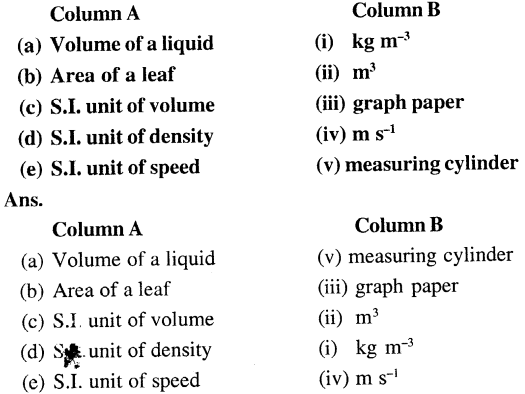
4. Select the correct alternative
(a) One litre is equal to :
- 1 cm-3
- 1 m3
- 10-3 cm3
- 10-3 m3
(b) A metallic piece displaces water of volume 15 ml. The volume of piece is :
- 15 cm3
- 15 m3
- 15 × 103 cm3
- 15 × 103 cm3
(c) A piece of paper of dimensions 1.5 m x 20 cm has area :
- 30 m2
- 300 cm2
- 0.3 m2
- 3000 m3
(d) The correct relation is :
- d = M × V
- M = d × Y
- V = d × M
- d = M + V
(e) The density of alcohol is 0.8 g cm-3. In S.I. unit, it will be :
- 0.8 kg m-3
- 0.0008 kg m-3
- 800 kg m-3
- 8 x 103 kg m-3
(f) The density of aluminium is 2.7 g cm-3 and of brass is 8.4 g cm-3. For the same mass, the volume of:
- both will be same
- aluminium will be less than that of brass
- aluminium will be more than that of brass
- nothing can be said.
(g) A block of wood of density 0.8 g cm-3 has a volume of 60 cm3. The mass of block will be :
- 60.8 g
- 75 g
- 48 g
- 0.013 g
(h) The correct relation for speed is
- Speed = distance x time
- speed = distance / time
- speed = time / distance
- speed = 1 / distance x time
(i) A boy travels a distance 150 m in 1 minute. His speed is
- 150 m s-1
- 2.5 m s-1
- 25 m s-1
- 9 m s-1
B. Short/Long Answer Questions
Question 1.
Define the term volume of an object.
Answer:
The space occupied by an object is called its volume.
Question 2.
State and define the S.I. unit of volume.
Answer:
S.I. unit of volume – The S.I. unit of volume is cubic metre. In short form, it is written as m3.
One cubic metre is the volume of a cube of each side 1 metre as shown in figure below i.e., 1 m3 = 1 m × 1 m × 1 m.
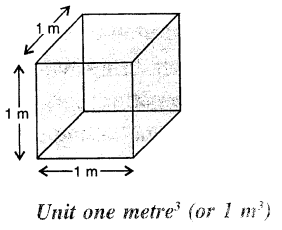
Question 3.
State two smaller units of volume. How are they related to the S.I. unit?
Answer:
A smaller unit of volume is cubic centimetre (symbol cm3) and cubic decimetre (symbol 1 dm3). One cubic centimetre is the volume of a cube of each side 1 centimetre, i.e.,
1 cm3 = 1 cm × 1 cm × 1 cm.
Relationship between m3 and cm3
l m3 = lm × lm × lm
= 100 cm × 100 cm × 100 cm
= 10,00,000 cm3 = 106 cm3.
Relationship between m3 and dm3
l m3 = lm × 1 m × 1 m .
= 10 dm × 10 dm × 10 dm
= 1000 dm
= 103 dm
Note 1 m = 10 dm
Question 4.
How will you determine the volume of a cuboid ? Write the formula you will use.
Answer:
Volume of a cuboid = length × breadth × height.
Question 5.
Name two devices which are used to measure the volume of an object. Draw their neat diagrams.
Answer:
Two devices that are used to measure the volume of an object are :
(i) Measuring cylinder and
(ii) Measuring beaker.
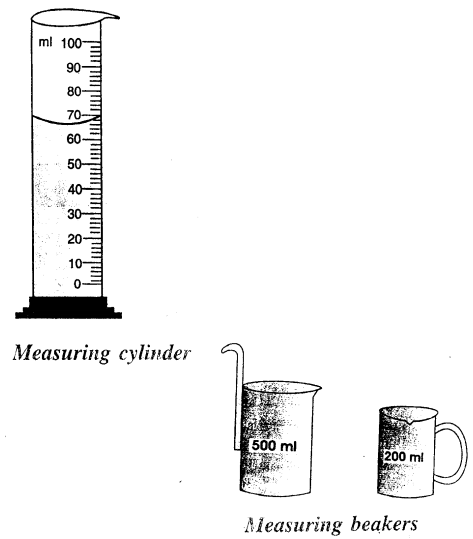
Question 6.
How can you determine the volume of an irregular solid (say a piece of brass) ? Describe in steps with neat diagrams.
Answer:
To measure the volume of a piece of stone.
Take a piece of brass, a measuring cylinder, fine thread of sufficient length and some water.
Place a measuring cylinder on a flat horizontal surface and fill it partially with water. Note the reading of the water level very carefully. Now tie the piece of brass with a thread and dip it completely into water. We see that the level of water rises. Note the reading of the new water level.
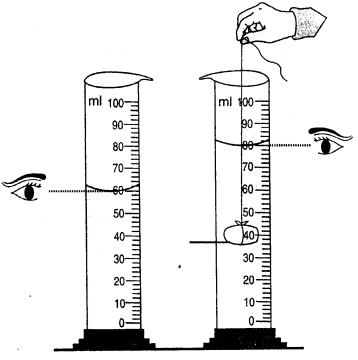
The difference in the two levels of water gives the volume of the piece of brass
Initial level of water = 60 ml
Level of water when brass is immersed = 80 ml
∴ Volume of water displaced = 80 ml – 60 ml = 20 ml
∴ Volume of the piece of brass = 20 cm3
Note : 1 ml = 1 cm3
Question 7.
You are required to take out 200 ml of milk from a bucket full of milk. How will you do it ?
Answer:
By using the measuring beaker A measuring beaker is used to measure a fixed volume of liquid from a large volume. Suppose it is required to measure 200 ml of milk from the milk contained in a bucket. For this, take the measuring beaker of capacity 200 ml. Wash it and dry it. Then, immerse the measuring beaker well inside the milk contained in the bucket so that the beaker gets completely filled with the milk.
Take out the measuring beaker from the bucket gently so that no milk splashes out and then pour the milk from the measuring beaker into the another empty vessel.
Question 8.
Describe the method in steps to find the area of an irregular lamina using a graph paper.
Answer:
Method to find the area of an irregular lamina using a graph paper : First, place the lamina over a graph paper and draw its boundary line on the graph paper with a pencil. Then remove the lamina and count and note the number of complete squares as well as the number of squares more than half within the boundary line (only the squares less than half, are left while counting). The area of lamina is equal to the sum of the area of complete squares and the area of squares more than half. Let n be the total number of complete and more than half or half squares within the boundary of lamina. Since area of one big square is 1 cm × 1cm = 1 cm2, so the area of lamina will be n x
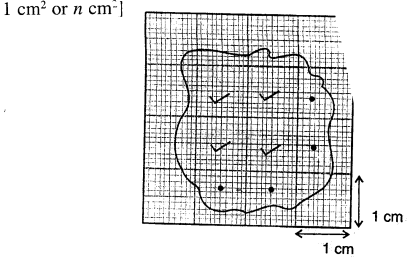
Question 9.
Define the term density of a substance.
Answer:
The density of a substance is defined as the mass of a unit volumx of that substance.
Question 10.
State the S.I. and C.G.S. units of density. How are they inte related ?
Answer:
The S.I. unit of mass is kilogram (symbol kg) and of volume is
cubic metre (symbol m3). Therefore S.I. unit of density is kg/m3
or kg m-3.
The C.G.S. unit of mass is gram (symbol g) and of volume is cubic centimetre (symbol cm3). Therefore the C.G.S. unit of
density is g/cm3 or g cm-3.

Question 11.
‘The density of brass is 8.4 g cm’3’. What do you mean by the statement ?
Answer:
Density of brass is 8.4 g cm-3. This means that unit volume of brass contain 8.4 g mass.
Question 12.
Arrange the following substances in order of their increasing density:
(a) iron
(b) cork
(c) brass
(d) water
(e) mercury
Answer:
b<a<c<d<e
Question 13.
How does the density of water changes when :
(a) it is heated from 0°C to 4°C,
(b) it is heated from 4°C to 10°C ?
Answer:
(a) Water contracts on heating from 0°C to 4°C and expands on heating above 4°C.
(b) The density of water is maximum at 4°C. It decreases when it is cooled from 4°C to 0°C or it is heated above 4°C.
Question 14.
Write the density of water at 4°C.
Answer:
The density of water at 4°C is 1.0 g cm-3, or 1,000 kg m-3
Question 15.
Explain the meaning of the term speed.
Answer:
The distance covered or travelled by a body in one second is called the speed of the body, i.e.

Question 16.
Write the S.I. unit of speed.
Answer:
The S.I. unit of speed is metre/second or metre per second. Its symbol is m s-1.
Question 17.
A car travels with a speed 12 m s”1, while a scooter travels with a speed 36 km h-1. Which of the two travels faster ?
Answer:
Speed of car = 12 m s-1
Speed of scooter = 36 km h-1
here, 1 km = 1000 m
1 hr = 3600 sec
![]()
∴ Speed of car is more. Car travels faster than scooter.
C. Numericals
Question 1.
The length, breadth and height of a water tank are 5 m, 2.5 m and 1.25 m respectively. Calculate the capacity of the water tank in (a) m3 (b) litre.
Answer:
Given,
Length (1) = 5m
Breadth (b) = 2.5 m
and Height (h) = 1.25 m

Question 2.
A solid silver piece is immersed in water contained in a measuring cylinder. The level of water rises from 50 ml to 62 ml. Find the volume of silver piece.
Answer:
Given, initial level of water .v1 = 50 ml
Final level of water v2 = 62 ml
Volume of silver piece V = v2 – v1
= 62 ml – 50 ml
= 12 ml or 12 cm3
Question 3.
Find the volume of a liquid present in a dish of dimensions 10 cm x 10 cm x 5 cm.
Answer:
Volume of water = Length × breadth × height
= 10 cm × 10 cm × 5 cm
= 500 cm3 or 500 ml.
Question 4.
A rectangular field is of length 60 m and breadth 35 m. Find the area of the field.
Answer:
Length of a rectangular field = 60 m
Breadth of rectangular field = 35 m
∴ Area = 60 m × 35 m
= 2100 m2
Question 5.
Find the approximate area of an irregular lamina of which boundary line is drawn on the graph paper shown in fig. 1.16. below.
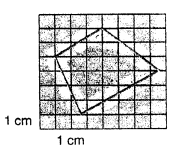
Answer:
From figure, the number of complete squares = 11
The number of squares more than half = 9
∴ Total number of squares = 11 + 9 = 20
∴ Area of the 1 square = 1 cm × 1cm = 1 cm2
∴ Area of 20 squares = 20 × 1 cm2 = 20 cm2
∴ Approximate area of irregular lamina = 20 cm2
Question 6.
A piece of brass of volume 30 cm3 has a mass of 252 g. Find the density of brass in (i) g cm-3, (ii) kg m-3.
Answer:
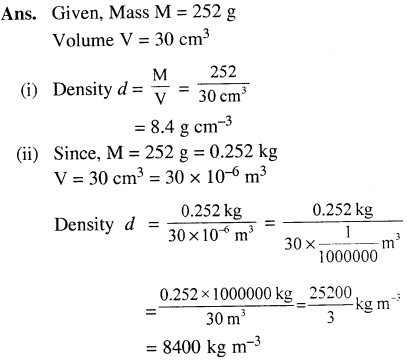
Question 7.
The mass of an iron ball is 312 g. The density of iron is 7.8 g cm-3. Find the volume of the ball.
Answer:

![]()
Question 8.
A cork has a volume 25 cm3. The density of cork is 0.25 g cm-3. Find the mass of cork.
Answer:
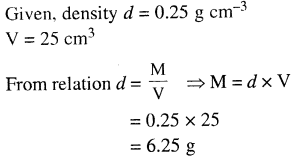
Question 9.
The mass of 5 litre of water is 5 kg. Find the density of water in g cm-3.
Answer:

Question 10.
A cubical tank of side 1 m is filled with 800 kg of a liquid. Find: (i) the volume of tank, (ii) the density of liquid in kg m-3.
Answer:
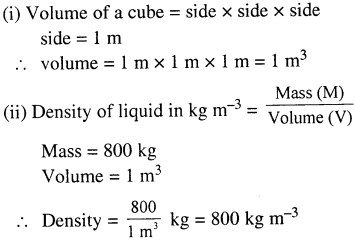
Question 11.
A block of iron has dimensions 2 m × 0.5 m × 0.25 m. The density of iron is 7.8 g cm-3. Find the mass of block.
Answer:
Given, l = 2m
b = 0.5 m

Question 12.
The mass of a lead piece is 115 g. When it is immersed into a measuring cylinder, the water level rises from 20 ml mark to 30 ml mark.
Find:
(i) the volume of the lead piece,
(ii) the density of the lead in kg m-3.
Answer:

Question 13.
The density of copper is 8.9 g cm-3. What will be its density in kg m-3 ?
Answer:

Question 14.
A car travels a distance of 15 km in 20 minute. Find the speed of the car in (i) km h-1, (ii) m s-1.
Answer:
Distance travelled by car =15 km
Time taken = 20 minutes
(i) Speed of car in km h-1
Convert 20 minutes to hour
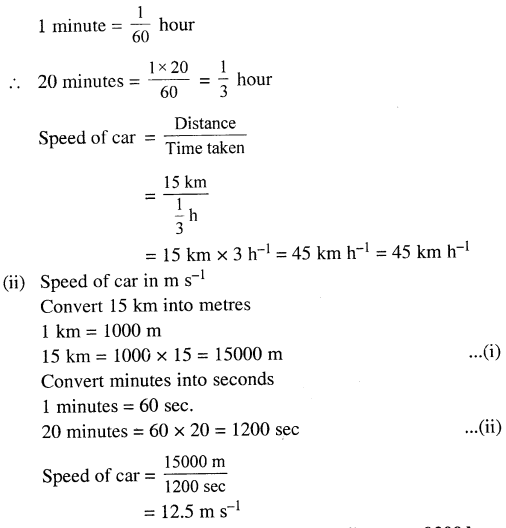
Question 15.
How long a train will take to travel a distance of 200 km with a speed of 60 km h-1 ?
Answer:
Distance covered by train = 200 km
Speed of train = 60 km h-1
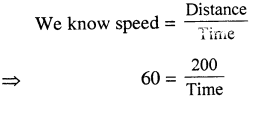

Question 16.
A boy travels with a speed of 10 m s-1 for 30 minute. How much distance does he travel ?
Answer:
Speed of boy = 10 m s-1
Time taken = 30 minutes
speed = distance travelled / time taken
Distance travelled = Speed × Time taken
Convert 30 minutes to seconds
1 minute = 60 sec
30 minute 60 × 30 = 1800 seconds
Putting the value of speed and time we get
Distance travelled = 10 ms-1 × (1800 sec) = 18000 m
= 18000 metre or 18 km Ans.
Question 17.
Express 36 km h-1 in m s-1
Answer:

Question 18.
Express 15 m s-1 in km h-1.
Answer:

